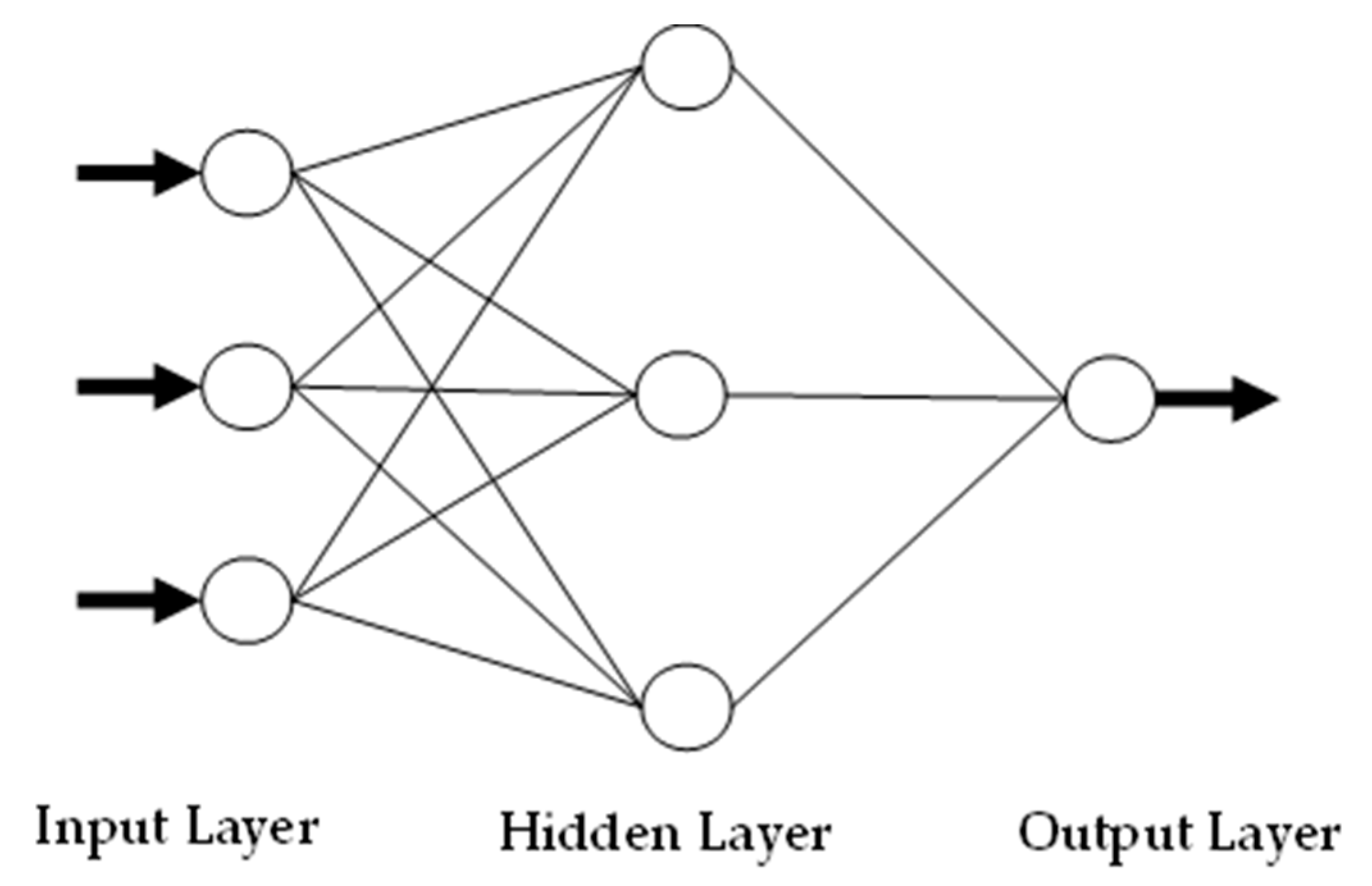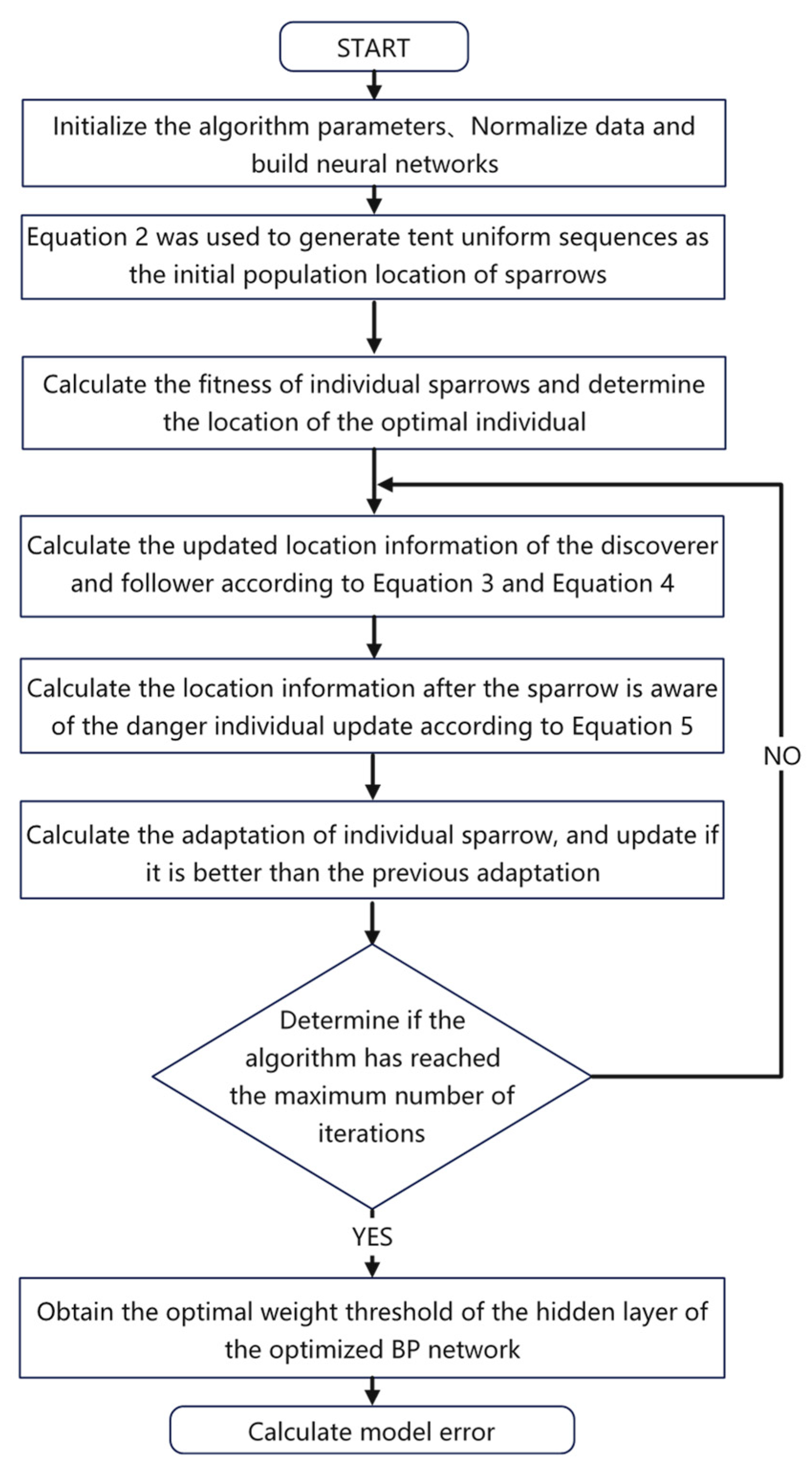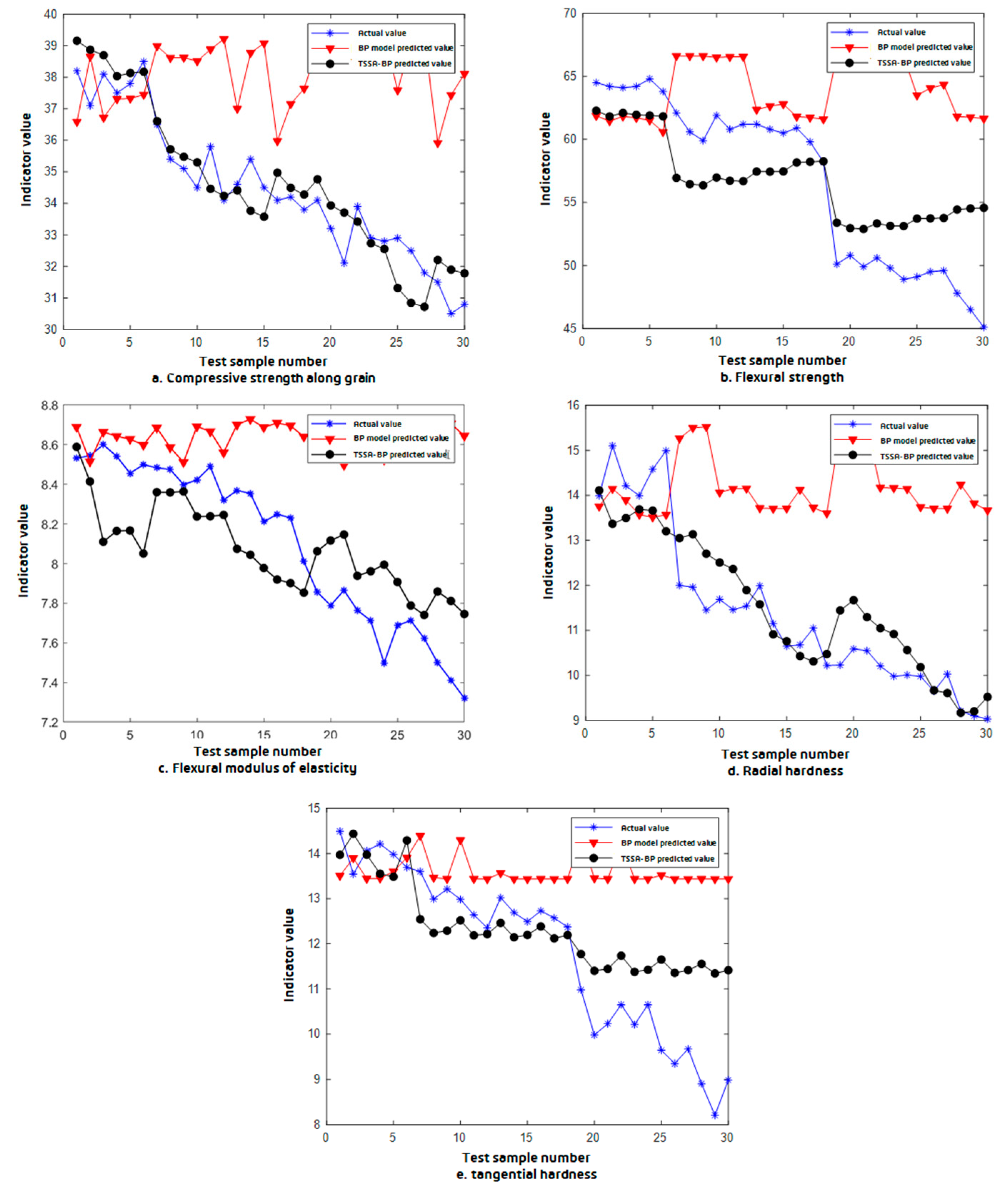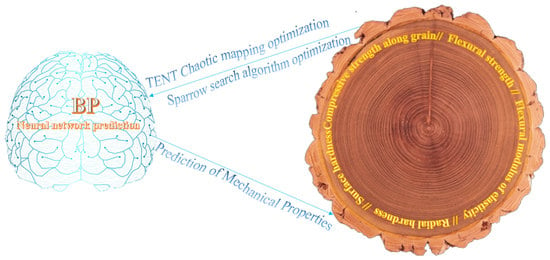Prediction of Mechanical Properties of Thermally Modified Wood Based on TSSA-BP Model
Abstract
:1. Introduction
2. Mechanical Properties of Wood
3. Establishment of BP Neural Network Model
3.1. Determination of Node Number of Input Layer and Output Layer
3.2. Determination of Number of Hidden Layer Nodes
4. Establishment of TSSA Model
4.1. Tent Chaotic Mapping
4.2. Sparrow Search Algorithm
4.3. TSSA-BP Model
5. Results and Discussion
6. Conclusions
Author Contributions
Funding
Institutional Review Board Statement
Informed Consent Statement
Data Availability Statement
Conflicts of Interest
References
- Callum, A.S.H. Wood Modification: Chemical, Thermal and Other Processes; John Wiley & Sons: Chichester, UK, 2006; pp. 260–262. [Google Scholar] [CrossRef]
- Sandberg, D.; Kutnar, A.; Mantanis, G. Wood modification technologies—A review. iFor.-Biogeosci. For. 2017, 10, 895–908. [Google Scholar] [CrossRef] [Green Version]
- Dong, X.; Jianpeng, H.; Lihong, Y. Research status and development of wood property prediction and quality control of heat treated wood. J. Zhejiang Agrofor. Univ. 2020, 37, 1–8. [Google Scholar] [CrossRef]
- Dubey, M.K.; Pang, S.; Walker, J. Changes in chemistry, color, dimensional stability and fungal resistance of Pinus radiata D. Don wood with oil heat-treatment. Holzforsch 2012, 66, 49–57. [Google Scholar] [CrossRef]
- Tjeerdsma, B.F.; Militz, H. Chemical changes in hydrothermal treated wood: FTIR analysis of combined hydrothermal and dry heat-treated wood. Holz Als Roh-Und Werkst. 2005, 63, 102–111. [Google Scholar] [CrossRef]
- Lu, J.; Huang, R.; Cao, Y.; Wu, Y.; Zhou, Y.; Zhao, Y.; Wu, Y. Effect of Steam Heat Treatment on Color of Chinese White Poplar Wood. Sci. Silvae Sin. 2012, 48, 126–130. [Google Scholar] [CrossRef]
- Rahimi, S.; Singh, K.; DeVallance, D. Effect of Different Hydrothermal Treatments (Steam and Hot Compressed Water) on Physical Properties and Drying Behavior of Yellow-Poplar (Liriodendron tulipifera). For. Prod. J. 2019, 69, 42–52. [Google Scholar] [CrossRef]
- Bal, B.C.; Bektaş, I. The Effects of Heat Treatment on Some Mechanical Properties of Juvenile Wood and Mature Wood ofEucalyptus grandis. Dry. Technol. 2013, 31, 479–485. [Google Scholar] [CrossRef]
- Papadopoulos, A.N.; Tountziarakis, P. Toughness of pine wood chemically modified with acetic anhydride. Eur. J. Wood Wood Prod. 2012, 70, 399–400. [Google Scholar] [CrossRef]
- Hadi, Y.S.; Massijaya, M.Y.; Zaini, L.H.; Pari, R. Physical and Mechanical Properties of Methyl Methacrylate-Impregnated Wood from Three Fast-Growing Tropical Tree Species. J. Korean Wood Sci. Technol. 2019, 47, 324–335. [Google Scholar] [CrossRef]
- Lee, S.H.; Ashaari, Z.; Lum, W.C.; Halip, J.A.; Ang, A.F.; Tan, L.P.; Chin, K.L.; Tahir, P.M. Thermal treatment of wood using vegetable oils: A review. Constr. Build. Mater. 2018, 181, 408–419. [Google Scholar] [CrossRef]
- Fathi, H.; Nasir, V.; Kazemirad, S. Prediction of the mechanical properties of wood using guided wave propagation and machine learning. Constr. Build. Mater. 2020, 262, 120848. [Google Scholar] [CrossRef]
- Dongyan, Z. Neural Network Prediction Model of Wood Moisture Content for Drying Process. Sci. Silvae Sin. 2008, 44, 94–98. [Google Scholar] [CrossRef]
- Nasir, V.; Nourian, S.; Avramidis, S.; Cool, J. Prediction of physical and mechanical properties of thermally modified wood based on color change evaluated by means of “group method of data handling” (GMDH) neural network. Holzforsch 2019, 73, 381–392. [Google Scholar] [CrossRef]
- Yang, H.; Cheng, W.; Han, G. Wood Modification at High Temperature and Pressurized Steam: A Relational Model of Mechanical Properties Based on a Neural Network. Bioresources 2015, 10, 5758–5776. [Google Scholar] [CrossRef]
- Bing, L.; Weisun, J. Chaos optimization method and its application. Control Theory Appl. 1997, 14, 613–615. Available online: https://en.cnki.com.cn/Article_en/CJFDTotal-KZLY199704028.htm (accessed on 25 October 2021).
- Kuang, F.J.; Xu, W.H.; Jin, Z. Artificial bee colony algorithm based on self-adaptive Tent chaos search. Control Theory Appl. 2014, 11, 1502–1509. [Google Scholar] [CrossRef]
- Williams, A.; Langridge, H.; Straathof, A.L.; Muhamadali, H.; Hollywood, K.A.; Goodacre, R.; de Vries, F.T. Hybridization algorithm of Tent chaos artificial bee colony and particle swarm optimi-zation. Control Decis. 2015, 30, 839–847. [Google Scholar] [CrossRef]
- Xue, J.; Shen, B. A novel swarm intelligence optimization approach: Sparrow search algorithm. Syst. Sci. Control Eng. 2020, 8, 22–34. [Google Scholar] [CrossRef]
- Barta, Z.; Liker, A.; Mónus, F. The effects of predation risk on the use of social foraging tactics. Anim. Behav. 2004, 67, 301–308. [Google Scholar] [CrossRef]
- Bautista, L.M.; Alonso, J.C.; A Alonso, J. Foraging site displacement in common crane flocks. Anim. Behav. 1998, 56, 1237–1243. [Google Scholar] [CrossRef] [Green Version]
- Jingyu, H. Research on Sparrow Search Algorithm Combining t-Distribution and Tent Chaotic Mapping. Master’s Thesis, Lanzhou University, Lanzhou, China, 21 May 2021. [Google Scholar] [CrossRef]
- Cai, J.; Luo, J.; Wang, S.; Yang, S. Feature selection in machine learning: A new perspective. Neurocomputing 2018, 300, 70–79. [Google Scholar] [CrossRef]
- Schubert, M.; Luković, M.; Christen, H. Prediction of mechanical properties of wood fiber insulation boards as a function of machine and process parameters by random forest. Wood Sci. Technol. 2020, 54, 703–713. [Google Scholar] [CrossRef]




| Test Temperature/°C | Test Time/h | Test Humidity/% | Compressive Strength along Grain/Mpa | Flexural Strength/Mpa | Flexural Modulus of Elasticity/Gpa | Radial Hardness/Mpa | Tangential Hardness/Mpa |
|---|---|---|---|---|---|---|---|
| 120 | 0.5 | 0 | 39.2 | 67.4 | 9.093 | 14.12 | 15.56 |
| 120 | 0.5 | 40 | 39.1 | 65.3 | 9.038 | 13.02 | 14.69 |
| 120 | 0.5 | 60 | 38.0 | 69.7 | 9.1 | 14.67 | 15.08 |
| 120 | 0.5 | 100 | 36.7 | 67.2 | 8.845 | 14.65 | 15.45 |
| 120 | 1 | 0 | 38.4 | 67.8 | 8.649 | 13.98 | 14.36 |
| 120 | 1 | 40 | 37.6 | 66.4 | 8.752 | 12.98 | 15.59 |
| 120 | 1 | 60 | 38.6 | 67.8 | 9.245 | 13.78 | 15.32 |
| 120 | 1 | 100 | 38.1 | 63.1 | 7.895 | 14.55 | 14.23 |
| 120 | 2 | 0 | 39.5 | 66.9 | 9.074 | 13.33 | 14.23 |
| 120 | 2 | 40 | 38.6 | 68.2 | 8.945 | 12.55 | 14.58 |
| 120 | 2 | 60 | 36.5 | 65.2 | 8.854 | 13.25 | 14.89 |
| 120 | 2 | 100 | 41.9 | 63.2 | 8.933 | 13.36 | 14.56 |
| 120 | 3 | 0 | 37.5 | 66.5 | 8.9 | 13.56 | 14.78 |
| 120 | 3 | 40 | 39.8 | 67.6 | 8.963 | 13.45 | 14.45 |
| 120 | 3 | 40 | 39.8 | 67.6 | 8.963 | 13.45 | 14.45 |
| 120 | 3 | 60 | 37.6 | 66.6 | 8.745 | 13.01 | 14.69 |
| 120 | 3 | 100 | 38.9 | 64.2 | 8.745 | 12.45 | 14.78 |
| 140 | 0.5 | 0 | 36.7 | 66.7 | 8.978 | 14.69 | 15.56 |
| 140 | 0.5 | 40 | 36.9 | 67.5 | 8.845 | 13.06 | 15.02 |
| 140 | 0.5 | 60 | 35.8 | 66.8 | 9.155 | 14.02 | 14.23 |
| 140 | 0.5 | 100 | 38.4 | 65.3 | 8.877 | 15.02 | 15.01 |
| 140 | 1 | 0 | 37.4 | 66.5 | 9.179 | 14.16 | 15.68 |
| 140 | 1 | 40 | 36 | 64.5 | 9.137 | 13.05 | 15.01 |
| 140 | 1 | 60 | 37.2 | 67.2 | 9.024 | 13.49 | 15.17 |
| 140 | 1 | 100 | 37.5 | 63.1 | 8.823 | 13.45 | 15.48 |
| 140 | 2 | 0 | 37.9 | 66.3 | 8.823 | 13.54 | 14.69 |
| 140 | 2 | 40 | 38.5 | 65.7 | 8.852 | 14.69 | 14.58 |
| 140 | 2 | 60 | 37.6 | 67.1 | 8.799 | 13.99 | 14.74 |
| 140 | 2 | 100 | 35.5 | 62.7 | 8.9 | 14.28 | 15.63 |
| 140 | 3 | 0 | 36.9 | 65.4 | 8.811 | 14.39 | 14.23 |
| 140 | 3 | 40 | 38.9 | 64.6 | 8.934 | 13.23 | 14.56 |
| 140 | 3 | 60 | 38.2 | 65.5 | 8.654 | 14.23 | 13.65 |
| 140 | 3 | 100 | 39.2 | 62.1 | 8.798 | 13.56 | 14.02 |
| 160 | 0.5 | 0 | 36.9 | 66.3 | 8.788 | 14.89 | 14.99 |
| 160 | 0.5 | 40 | 39.1 | 66.9 | 9.011 | 14.87 | 14.36 |
| 160 | 0.5 | 60 | 37.1 | 66.3 | 8.745 | 14.58 | 14.78 |
| 160 | 0.5 | 100 | 38.9 | 65.8 | 8.712 | 14.69 | 15.69 |
| 160 | 1 | 0 | 39.1 | 62.4 | 8.679 | 13.42 | 14.56 |
| 160 | 1 | 40 | 39.7 | 61.4 | 8.645 | 14.09 | 15.3 |
| 160 | 1 | 60 | 37.8 | 62.2 | 8.798 | 14.69 | 15.9 |
| 160 | 1 | 100 | 38.7 | 62.8 | 8.679 | 13.58 | 15.63 |
| 160 | 2 | 0 | 35.9 | 62.2 | 8.727 | 14.63 | 13.92 |
| 160 | 2 | 40 | 35.8 | 62.1 | 8.557 | 14.02 | 14.17 |
| 160 | 2 | 60 | 36.6 | 63.1 | 8.687 | 15.17 | 14.28 |
| 160 | 2 | 100 | 38.2 | 60.9 | 8.611 | 14.65 | 15.09 |
| 160 | 3 | 0 | 37.2 | 61.9 | 8.611 | 13.65 | 14.36 |
| 160 | 3 | 40 | 39.1 | 61.5 | 8.534 | 13.47 | 14.56 |
| 160 | 3 | 60 | 39.5 | 60.8 | 8.601 | 13.58 | 13.89 |
| 160 | 3 | 100 | 37.3 | 60.5 | 8.552 | 13.69 | 14.36 |
| 180 | 0.5 | 0 | 38.9 | 65.9 | 8.601 | 15.21 | 14.03 |
| 180 | 0.5 | 40 | 39.1 | 65.3 | 8.689 | 15.98 | 14.56 |
| 180 | 0.5 | 60 | 37.6 | 66.1 | 8.645 | 16.01 | 13.97 |
| 180 | 0.5 | 100 | 36.1 | 65.7 | 8.599 | 14.32 | 14.33 |
| 180 | 1 | 0 | 38.2 | 65.4 | 8.623 | 15.09 | 13.79 |
| 180 | 1 | 40 | 39.4 | 64.9 | 8.645 | 14.98 | 14.25 |
| 180 | 1 | 60 | 37.6 | 66.3 | 8.579 | 15.45 | 14.08 |
| 180 | 1 | 100 | 38.1 | 64.8 | 8.545 | 14.33 | 13.64 |
| 180 | 2 | 0 | 39.5 | 65.1 | 8.574 | 14.65 | 13.69 |
| 180 | 2 | 40 | 38.7 | 65.8 | 8.6 | 14.13 | 13.59 |
| 180 | 2 | 09 | 38.2 | 64.5 | 8.532 | 13.99 | 14.49 |
| 180 | 2 | 100 | 37.1 | 64.2 | 8.544 | 15.1 | 13.54 |
| 180 | 3 | 0 | 38.1 | 64.1 | 8.6 | 14.21 | 14.06 |
| 180 | 3 | 40 | 37.5 | 64.2 | 8.541 | 13.99 | 14.21 |
| 180 | 3 | 60 | 37.8 | 64.8 | 8.456 | 14.58 | 13.98 |
| 180 | 3 | 100 | 38.5 | 63.8 | 8.499 | 14.99 | 13.69 |
| 200 | 0.5 | 0 | 36.5 | 62.1 | 8.483 | 12 | 13.6 |
| 200 | 0.5 | 40 | 35.4 | 60.6 | 8.475 | 11.96 | 12.99 |
| 200 | 0.5 | 60 | 35.1 | 59.9 | 8.399 | 11.45 | 13.21 |
| 200 | 1 | 0 | 34.5 | 61.9 | 8.422 | 11.69 | 12.98 |
| 200 | 1 | 40 | 35.8 | 60.8 | 8.489 | 11.46 | 12.64 |
| 200 | 1 | 60 | 34.1 | 61.2 | 8.321 | 11.54 | 12.35 |
| 200 | 2 | 0 | 34.6 | 61.2 | 8.369 | 11.99 | 13.02 |
| 200 | 2 | 40 | 35.4 | 60.8 | 8.354 | 11.15 | 12.69 |
| 200 | 2 | 60 | 34.5 | 60.5 | 8.211 | 10.65 | 12.49 |
| 200 | 3 | 0 | 34.1 | 60.9 | 8.249 | 10.68 | 12.73 |
| 200 | 3 | 40 | 34.2 | 59.8 | 8.231 | 11.05 | 12.57 |
| 200 | 3 | 60 | 33.8 | 58.2 | 8.011 | 10.22 | 12.37 |
| 210 | 0.5 | 0 | 34.1 | 50.1 | 7.856 | 10.23 | 10.98 |
| 210 | 0.5 | 40 | 33.2 | 50.8 | 7.789 | 10.59 | 9.98 |
| 210 | 0.5 | 60 | 32.1 | 49.9 | 7.865 | 10.55 | 10.23 |
| 210 | 1 | 0 | 33.9 | 50.6 | 7.765 | 10.21 | 10.65 |
| 210 | 1 | 40 | 32.9 | 49.8 | 7.712 | 9.98 | 10.21 |
| 210 | 1 | 60 | 32.8 | 48.9 | 7.498 | 10.01 | 10.65 |
| 210 | 2 | 0 | 32.9 | 49.1 | 7.689 | 9.98 | 9.64 |
| 210 | 2 | 40 | 32.5 | 49.5 | 7.712 | 9.65 | 9.35 |
| 210 | 2 | 60 | 31.8 | 49.6 | 7.623 | 10.03 | 9.67 |
| 210 | 3 | 0 | 31.5 | 47.8 | 7.5 | 9.21 | 8.91 |
| 210 | 3 | 40 | 30.5 | 46.5 | 7.412 | 9.1 | 8.21 |
| 210 | 3 | 60 | 30.8 | 45.1 | 7.321 | 9.03 | 8.99 |
| Number of Hidden Layer Nodes | Mean Square Error of Training Set Simulation |
|---|---|
| 3 | 0.076652 |
| 4 | 0.080913 |
| 5 | 0.11162 |
| 6 | 0.098472 |
| 7 | 0.11095 |
| 8 | 0.20944 |
| 9 | 0.048599 |
| 10 | 0.10292 |
| 11 | 0.053805 |
| 12 | 0.080683 |
| Error | BP Model Error Data |
|---|---|
| Mean absolute error | 3.1008 |
| Mean square error | 11.7437 |
| root mean square error | 3.4269 |
| Mean absolute percentage error | 29.4895% |
| BP Neural Network | TSSA-BP Neural Network | |||||||
|---|---|---|---|---|---|---|---|---|
| MAE | MSE | RMSE | MAPE | MAE | MSE | RMSE | MAPE | |
| Compressive Strength along Grain | 3.0589 | 15.2339 | 3.9031 | 9.23% | 1.0031 | 1.4796 | 1.2164 | 2.90% |
| Flexural Strength | 8.3386 | 108.3442 | 10.4089 | 16.19% | 3.6837 | 16.9941 | 4.1224 | 6.81% |
| Flexural Modulus of Elasticity | 281.1056 | 2,359,375 | 1536.026 | 11.84% | 282.5553 | 2,357,955 | 1535.563 | 31.26% |
| Radial Hardness | 3.1008 | 11.7437 | 3.4269 | 29.49% | 0.65949 | 0.66027 | 0.81257 | 5.64% |
| Tangential Hardness | 1.9485 | 6.3025 | 2.5105 | 19.12% | 0.9944 | 1.5728 | 1.2541 | 9.61% |
Publisher’s Note: MDPI stays neutral with regard to jurisdictional claims in published maps and institutional affiliations. |
© 2022 by the authors. Licensee MDPI, Basel, Switzerland. This article is an open access article distributed under the terms and conditions of the Creative Commons Attribution (CC BY) license (https://creativecommons.org/licenses/by/4.0/).
Share and Cite
Li, N.; Wang, W. Prediction of Mechanical Properties of Thermally Modified Wood Based on TSSA-BP Model. Forests 2022, 13, 160. https://doi.org/10.3390/f13020160
Li N, Wang W. Prediction of Mechanical Properties of Thermally Modified Wood Based on TSSA-BP Model. Forests. 2022; 13(2):160. https://doi.org/10.3390/f13020160
Chicago/Turabian StyleLi, Ning, and Wei Wang. 2022. "Prediction of Mechanical Properties of Thermally Modified Wood Based on TSSA-BP Model" Forests 13, no. 2: 160. https://doi.org/10.3390/f13020160
APA StyleLi, N., & Wang, W. (2022). Prediction of Mechanical Properties of Thermally Modified Wood Based on TSSA-BP Model. Forests, 13(2), 160. https://doi.org/10.3390/f13020160






